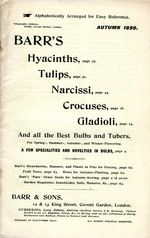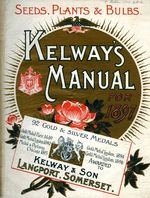
Barr's Hyacinths, Tulips, Narcissi, Crocuses, Gladioli, and all the Best Bulbs and Tubers, etc. Autumn 1899. (Click for more images)
The British catalogues in the OSU collection, dating from the late nineteenth century until the first World War, though few in number, provide evidence of the highly advanced state of British horticulture at that time. Companies scoured the globe to be first to introduce new exotics. At the same time, spurred by the English writer William Robinson, gardeners in the 1890s rebelled against the formal geometric carpet bedding style and turned instead to old-fashioned hardy cottage garden flowers and wildflowers. Influenced by Robinson, the designer and writer Gertrude Jekyll was instrumental in popularizing cottage gardens and perennial borders with harmonious flower and foliage colors and forms. She, along with other writers, also fostered a renewed appreciation for fragrant plants. Many catalogues of the late nineteenth and early twentieth century specialized in hardy perennials for herbaceous borders, and the “wild garden”, including alpine and rock garden plants, woodland plants, bulbs and water lilies. Delphiniums, roses, peonies, carnations, chrysanthemums, daffodils, gladioli, hyacinths and tulips are some of the most common species represented in the OSU collection from this period. Kelway’s Manual of 1913 printed testimonials sent by Jekyll and Robinson.
From the 1890s come catalogues of two British specialists, James Kelway who introduced new varieties of peonies and delphiniums, and Peter Barr, who collected and hybridized daffodils. Both nurseries also supplied a vast number of hardy perennials and alpine plants. Barr’s catalogue of 1903 is also the first in the OSU collection to list a telephone number. Scans from Kelway’s Manual of 1897 of their delphinium and peony pages, and a photograph of Barr’s Nursery in 1899 are available.

